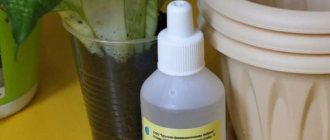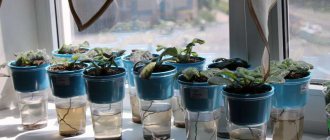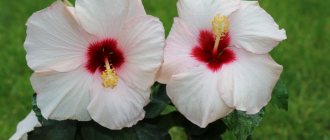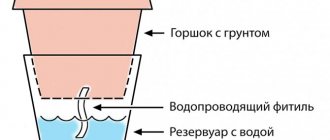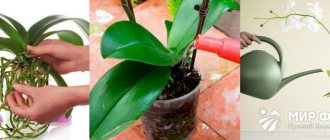Features of wick irrigation
Many gardeners love small plants that grow in small pots with loose substrate. Chirites, Saintpaulias, Achimenes, Episcias, Gloxinias and other flowers must be watered every other day. If you only have a few of these plants, then you can still cope with watering them. But if the collection is large or you have to go on vacation for a week, the problem of watering becomes quite acute. In this case, experts recommend paying attention to wick watering. This method provides water and all nutrients to the plant on time. The liquid rises along a synthetic cord to the roots of the plants. So, how to make wick watering?
What plants like this kind of watering?
A constantly moistened earthen ball imposes certain conditions. It is best to use a wick for crops that do not require drying of the substrate. These are Saintpaulias, Gloxinias, Streptocarpus and other indoor plants without a pronounced resting phase. The main thing is to prevent cold air from entering the room. This will lead to the death of the plants because the roots will not be able to absorb water in the required quantity. Reducing the duration of daylight hours when using wick irrigation requires the organization of additional illumination with phytolamps or fluorescent ones. There are plants that need to reduce watering levels in the fall and spring. Such indoor flowers receive wick watering only during the period of active growth. It should be remembered that such a system does not have to be used on an ongoing basis; it is well suited for those who often go on vacation. The main thing is to pour enough water into the tank.
Advantages and disadvantages
Wick watering is used by many gardeners. This method of care has its advantages and disadvantages.
Pros:
- Watering plants is kept to a minimum: 1-2 times a month.
- Plants grow actively and bloom faster.
- The roots do not dry out, because they receive the required amount of water.
- You can leave home for a long period without worrying about your green home garden.
- Such plants bloom profusely, lushly and brightly, compared to other plants. Buds and flowers are larger.
Minuses:
- The vital activity of these plants proceeds faster, so their aging occurs faster.
- In a room with high humidity and air temperature below +18°C, there is a risk of developing fungal diseases and rotting of the root system.
Growing plants on a wick in a soil mixture
First of all, you need to choose soil that is suitable for a particular plant. To make wick watering for plants, it is necessary that 35-40% of its volume be occupied by perlite, which ensures looseness of the soil. You can apply fertilizers on the wick in the usual way, adding the solution in small doses, watering the soil from above. But make sure that fertilizers do not get into the water with the wick watering container. You can also use foliar feeding.
You definitely need to keep an eye on the plant. If the leaves begin to discolor or turn yellow, it is better to replant the plant in new soil.
How often to water violets
Violets are plants that need regular watering: daily or every 1-2 days. Moreover, it is advisable to water them in a special way - not like other flowers, but more on that below. As for the watering time required for the plant, it is quite simple to determine. Look at the plant - if its lower leaves have lost their elasticity and are bent down, then it’s time to start watering. Also touch the soil - if the soil is dry, then it is clear that the plant has already taken almost all the water and needs new moisture. As for young violets, the soil needs to be constantly kept moist, so it is recommended to water such plants daily.
Growing in soilless mixture
Many gardeners also use the method of growing plants on wicks in a soilless mixture. In this case, the soil will consist of perlite and peat, taken in equal proportions. This mixture contains virtually no nutrients, so when wicking violets, all plants are grown in special containers with a nutrient solution. In this case, the following fertilizers are often used: Kemira Lux, Etisso, Pokon.
To create a nutrient solution, you must study the manufacturer's recommendations. For example, to make a nutrient solution from Etisso Hydro fertilizer, you need to use 3 ml of the product per 1 liter of water.
What should the pot be like?
As mentioned above, violets develop better in small pots, receiving nutrition not from the soil, but from the solution.
To avoid the accumulation of harmful impurities in small quantities of the substrate, violets must be replanted once every six months.
Soil selection
Regular soil used for growing plants is too heavy for violets and absorbs a lot of water, causing it to become compacted and sour.
When using wick irrigation, the soil should be loose and breathable. A baking powder (river sand, vermiculite, perlite) is placed in the pots along with peat - the soil is completely excluded.
The soil may consist of:
- store-bought soil for violets, compressed coconut peat, perlite or vermiculite - all in equal proportions;
- coconut peat perlite or vermiculite - in equal proportions;
- soil for violets perlite vermiculite.
Coco peat needs to be washed as it contains a large amount of salts. You need to wash it several times.
Wick or cord
A synthetic cord is used as a wick, since natural material undergoes rapid rotting.
The cord must have good water absorption.
When using wicks from nylon stockings or tights, the soil becomes soaked due to too much water absorption.
Violets develop best in small pots, since they receive nutrients not from the soil, but from the solution. To obtain a beautifully formed rosette with a large head of flowers, a pot with a diameter of 5-8 cm is perfect.
REFERENCE: To prevent harmful impurities from accumulating in a small volume of soil, violets must be replanted once every six months.
Soil selection
Ordinary soil, which is used to grow other plants, is quite heavy for violets: the ability to absorb large volumes of water leads to compaction and souring of the substrate. To use wick irrigation, the substrate must be loose and breathable. Baking powder is added to the pot with peat - the soil must be completely excluded. The soil should consist of:
- Store-bought soil for violets, pressed coco peat, perlite or vermiculite - in equal proportions;
- Coconut peat, perlite or vermiculite - also in equal proportions;
- Soil for violets, perlite, vermiculite.
However, if the proportions are violated and the conditions of maintenance are not observed, phytosporin will not be effective. Coco peat needs to be washed as it has a high salt content. Carry out several washes.
Wick or cord
Basic requirements for the cord:
- Give preference to synthetic cord, since natural cord will quickly rot;
- The cord must be hygroscopic;
- The thickness of the cord when using a pot with a diameter of 5-8 cm should be 0.5 cm.
ATTENTION: It is not recommended to use wicks from stockings or tights made of nylon, since the high hygroscopicity of the material leads to soaking of the substrate
Wick cord
Having decided to make wick irrigation yourself, you need to pay special attention to the choice of cord. It must be made of synthetic material. This eliminates the possibility of rotting of the material.
The cord should conduct water well. To do this, just take a small piece of material and immerse its tip in water. It should get wet quickly.
For a flower pot with a diameter of 9 cm, you must use a cord with a diameter of 1.5-2 mm. The cord should be long enough to reach the bottom of the container.
After installing the wick cord, it is necessary to check how wet the earthen lump is during the first 2 weeks. Pay attention to whether the turgor of the plants changes or whether the water in the container decreases.
If the soil in the pot is dry, you need to install an additional cord. If the soil, on the contrary, is waterlogged, you need to observe the plant for several days. Perhaps you chose a cord that is too thick or the plant's root system is not very developed.
LiveInternetLiveInternet
What is “wick watering”? Wick irrigation is an irrigation method that uses the capillary properties of a cord, due to which water from a container under the pot rises along the wick and releases moisture to the substrate. As soon as the substrate dries out, the water “pulls up” again. As a result, the plant receives only the amount of water that it needs at a given time under given conditions. If conditions change (it becomes hot or cold, air humidity increases or decreases, the plant grows, etc.), then the amount of incoming liquid will also change to what your violet needs.
Of course, there are some disadvantages : 1. If the system is not designed correctly and the substrate is waterlogged, the roots may rot. However, even with normal watering, this phenomenon is by no means uncommon! 2. When over-watered, small flies may appear - sciarids (fungus gnats). However, since their larvae feed on decaying organic matter (leaf soil, etc.), the chances of getting them with regular soil mixture (and, accordingly, regular watering) are much greater. 3. Some people complain that when transferred to a wick, the violets become much larger in size. This is true if you leave them in ordinary 10-12 cm pots. However, wick watering requires a smaller container, and in a 5.5-8 cm pot, violets feel comfortable, bloom profusely, but the size of the rosette remains normal! 4. Many people worry that when a container with violets is on the windowsill, the water in the trays cools down and the plants drink cold water. Yes, this is a minus. But when you water each violet separately with warm water, then on the same windowsill the moistened earthen lump instantly cools down and the roots are in the cold substrate. That is, there is no difference in this case. The only way out, regardless of the method of watering, is to either insulate the windowsill or move the violets to a warmer place during the cold period.
What are the advantages of wick watering when used correctly: 1. Violets grow in the most comfortable conditions, without experiencing stress from overwatering or drying out; 2. Having found the optimal concentration of the fertilizer solution, you will not overfeed or underfeed the violets; 3. Growing violets becomes very easy: you don’t need to check every day to see if the earth ball is dry and run around with a watering can/pear/dropper to measure out the amount of water the plant needs; 4. In winter, due to the high dryness of the air, the top layer of soil dries out, but moisture remains inside. And you can easily flood the plant. Whereas with wick watering, the substrate is wetted evenly: the top layer dries out and moisture is immediately drawn from below; 5. You can leave violets for a long time (several weeks), for example, during vacation, and not ask your neighbor/friend/mother to water your pets; 6. It is very easy to root and grow a large number of violets, since you do not have to water each pot separately; 7. If it comes to rooting leaf cuttings, then you will not miss the moment of evaporation of water from the glass (also very important with a large number of violets); 8. Thanks to comfortable conditions, violets not only bloom more luxuriantly, but also bloom much earlier;
9. Violets love high air humidity, but it is quite difficult to provide it without special humidifiers. But with wick watering, water will constantly evaporate little by little from the reservoirs with the solution, which will create additional humidity in the air near the plant; 10. Mini-violets, which are grown in very small pots, can dry out literally within a day with normal watering, so wick watering is very convenient when growing them; 11. Since the food will come from the solution, and not from the soil, the pot needs to be small (even less than 1/3 of the diameter of the outlet), and this means a certain saving both on the amount of substrate and on the pots themselves (the larger the diameter, the higher the price); 12. With a small diameter of the pot, the rosette is small, but evenly developed. Energy is spent on flowering, and not on gaining green mass; 13. As a result, you will get healthy, well-developed, abundantly blooming violets, since with wick watering the plants receive all the necessary microelements from the solution, and the violet regulates the level of soil moisture itself.
We have been using wick watering since 2005 and have noticed that violets have begun to grow much better than when watered in a tray. Their leaves are clean (without traces of drops, which are almost inevitable with normal watering), and the head of flowers is much larger and denser.
How to organize such a wonderful system? Let's consider two examples - rooting leaf cuttings in sphagnum moss using wick irrigation and growing children and adult plants using wick irrigation. For both of them there are 3 common points : the wick, the solution and the container for wick watering.
The wick must be synthetic (cotton will rot very quickly) and be well wetted, that is, have capillary properties. This is a very important point, since not all synthetic cords are hygroscopic, so it is advisable to check this in advance (you can ask them to wet a small area right in the store). We cut the wick into pieces about 20 cm long. The thickness of the wick is usually small. For pots with a diameter of 4-8 cm, we use a cord about 0.5 cm thick. The most common misconception is that many people believe that the larger the diameter of the cord, the more the substrate is wetted. This is wrong! The fact is that the wick is just a “conductor”, and the “pump” is the surface of the substrate in the pot. Even simpler: water does not “enter”, but is “pulled up” according to the law of capillaries when the top layer of the loose substrate dries out. That is, the substrate will take exactly as much water as it needs. Do not forget that this only works with the correct substrate for wick irrigation (very moisture- and breathable). If you use a dense substrate, it will retain excess water.
The color of the wick does not matter, the main thing is that it does not color the water (otherwise it may affect the color of the leaves and flowers). Some people make wicks from used nylon tights. On the one hand, this is convenient, since they are almost always at hand, but, according to reviews, such wicks conduct water too well and the substrate becomes soaked. The main thing is that the end of the wick constantly touches the solution, and the bottom of the pot remains dry. The distance between the bottom and the water level is usually about 1-5 cm and depends on the length of the wick and the amount of water in the tray. What is important is not the length of the wick itself, but the distance from the water to the pot (there may be another half meter of wick lying in the solution - no big deal). This “air” section of the wick is a kind of “engine” of the entire system: when it dries out (and therefore the soil in the pot dries out), water, according to the law of capillaries, is pulled up into the pot. If you make this distance too large, then the wick will dry out due to its large length, and not because the soil has already dried... We use trays 7 cm high, which are about 6 cm filled with solution, with a plastic plate on top with holes on which cups or pots stand. The end of the wick touches the bottom of the tray, that is, the solution can be added quite rarely (depending on the number of pots, air humidity and other conditions).
To prepare the solution, you can use any water-soluble mineral complex microfertilizer. For many years we have been using Kemira Combi . In this case, we prepare a 0.05% solution . It is very convenient to dilute, for example, the entire pack (20 grams) in 1 liter of water and keep it closed away from children (so as not to confuse it with soda). And dilute as needed in the proportion you need! By the way, don’t forget to write on the bottle what’s in it and how to dilute it. For example, when diluting 1 package (20 grams) in 1 liter of water, a 2% solution is obtained. Take 25 ml (5 teaspoons) and dilute it in 1 liter of water - you get a 0.05% solution. Or 50 ml in 2 liters - the effect is the same. It’s more convenient for everyone - how many plants they have. Kemira solution can be stored for a very long time. If it precipitates, shake it and use it for its intended purpose.
The container for the solution - a container for wick watering - can be individual for each plant, or common for several. The first option has an undoubted advantage in that if there is some kind of nasty stuff in the water, then other violets will not be harmed.
However, we have been growing violets on trays for many years, from which 6-8 children, or 2-3 rosettes, drink. And we never had any problems. And it is much easier to add solution to several large containers than to many small ones.
Sometimes a green coating appears on the walls of the container with the solution - this is algae. There is nothing wrong with them - they do not affect the vital activity of violets. Perhaps the only negative is an aesthetic defect. But sometimes you can wash your containers/trays/reservoirs to remove the greens.
Another point is the greenhouse . Everything is simple here: if there is an opportunity, then it’s worth doing it - both the cuttings and the children will grow in much more comfortable conditions. If this is not possible, then its absence will at least to some extent be compensated by the evaporation of water from the trays and the correct humidity of the substrate in the pot.
Now let's take a closer look at the technology.
When rooting leaf cuttings in sphagnum moss using wick irrigation, you will need: Basics: 1. Live sphagnum moss; 2. Plastic cups (180-200 ml); 3. Correct wick; 4. Fertilizer type Kemira Combi; Additionally: 1. Marker or stickers (adhesive price tags); 2. Burning machine or wire/awl; 3. Scissors; 4. Blade or stationery knife; 5. Sticks for spreading leaves.
So, you need to make small holes in the cups so that you can thread the wick through it. We usually use a burning machine for this, but heated wire or a thick awl will also work. You can cut holes with a knife with a sharp tip.
The names of the varieties can be written with a marker on the cup or with a pen on adhesive price tags. You can also use a marker to label the coffee stirring sticks and place them in cups. It’s more convenient for anyone.
We cut living sphagnum moss into pieces of 2-5 cm (as it turns out) - this way it will be easier to separate the roots of the children from the moss itself.
By the way, don’t be surprised when, after some time, the chopped moss begins to grow - new green stems will appear. This is a very good sign, since living moss has bactericidal properties and thereby prevents the cuttings from rotting. Sometimes moss growth is so intense that you have to remove the excess to make it easier to plant the babies later! We are preparing a 0.05% solution of Kemira Combi, which our cuttings and subsequently children will drink. You can also root in clean water (before the babies form), but in our experience, when using a fertilizer solution, the babies appear faster. We pass the wick through the hole so that at the bottom of the cup we get a half-ring of cord, the rest remains outside. We place cut sphagnum moss on the ring so that it is about 3-4 cm in height, it can be slightly compacted.
For leaf cuttings of violets, we make a cut at an angle, leaving a petiole length of about 2-3 cm. Some prefer not to cut, but to break off the cutting - this is also the right option. If you are a beginner violet grower and are afraid that the cuttings will rot, then you can leave the petiole longer (so that you can trim it if necessary), but it is more convenient to root petioles that are not long. We insert a leaf cutting into the sphagnum so that the cut is covered with moss, but does not reach the plastic bottom. Many people recommend first dipping cuttings into Kornevin. We don’t do this (everything takes root well here anyway ), but, according to reviews, it really speeds up the process of root formation.
To prevent the leaf from falling (if it is large or, conversely, too small), it is advisable to prop it up with a special stick. The same coffee stirring sticks, broken or cut in half, are suitable for this. You can come up with something else, the main thing is that you should not use wooden sticks - they quickly begin to rot the leaf plates. It is best for each leaf to have its own glass (if one of the pair rots, the second one will not “get infected”, and the children will then feel more at ease). But in order to save space, you can place 2 leaves of the same variety in one glass. In this case, spacer sticks are simply necessary.
If the leaf plate is very large and does not fit into the cup, then you can safely cut the edges at a slight angle (as if parallel to the walls of the cup). For reliability, the sections can be sprinkled with crushed charcoal (if you don’t have charcoal, you can crush activated carbon tablets).
When all the leaves have found their homes, the cups need to be placed in a tray with the solution so that the wicks get wet and the moss is completely saturated with water. This is very important, because otherwise the system will not work. If you don’t have a tray, you can pour some moss on top. After this, the cups can be placed on the container for wick watering.
After about 10-14 days, you will see that the leaves seem to stand up in the cups and become more elastic. And if you pull them slightly, you will feel resistance. This means that everything is going well and the first roots have appeared. At this stage, you can do without backlighting. But babies will appear much faster if you organize additional lighting. The rate of formation of children varies greatly among different varieties and depending on different conditions, on average from 1 to 3 months and even longer. If the leaves sit for a long time without children, they need to be “stimulated” - cut off the top 1/3 of the leaf, and sometimes ½ if the leaf is very large. Do not forget that violets must be protected from drafts, and the optimal temperature for them is above 22 degrees.
Some leave the cuttings in the moss only until well-developed roots form, and then replant. We prefer the option when the leaves take root in the moss, produce babies, and the babies grow in the moss with wick watering to the age when they can be planted separately.
This is usually determined by the size of the baby (about 1/3-1/4 in height from the mother leaf) and the amount of green pigment for variegated varieties. By the way, after the separation of the firstborns, the leaf can be left in the sphagnum and it will give you another generation of children.
Now let's talk about growing children and adult plants using wick irrigation.
The only difference between leaves and babies is that for rosettes a wick mixture is used, in which there is no place for sphagnum. Also, according to our observations, you should not add soil to the mixture, as this will lead to rotting of the roots of children and adult violets (sphagnum and soil strongly draw water onto themselves). So, we use only soilless mixture . Usually we take 50% high-moor (red) peat and 50% perlite, vermiculite or a mixture of them.
You can also use a mixture of coco peat/substrate and perlite, since coconut fiber remains porous even after being saturated with water, which promotes active root formation and better plant growth. But don’t forget to rinse the “coconut” before using it – it contains quite a lot of salts. The soilless mixture for wick irrigation turns out to be very loose, moisture- and breathable, and thanks to this the root system becomes well and evenly developed. Place a turn/half turn of the wick on the bottom of the pot. We usually make the ring slightly smaller than the circumference of the pot.
Some people thread the wick through the entire thickness of the mixture, but this is not necessary: due to the looseness and moisture permeability of the substrate, the solution will evenly wet the entire mixture in the pot. Sometimes it is recommended to put some kind of synthetic material on the bottom so that the substrate does not spill out, but with a small diameter of the holes in the pot, the wet mixture will not go anywhere. Thus, we fill the wick on top with the substrate and plant the baby. No drainage is required for wick irrigation.
If, after separating from the leaf, you are left with very small children, there is no need to give up on them: be sure to plant them in a pot with the same mixture, and they will probably take root. In such a substrate, roots develop very quickly!
We place the pot on a tray with water so that the entire system is saturated with the solution. You can also thoroughly flush the system from above, but this is less convenient. You may have to sprinkle the substrate a little on top, as the water will cause it to settle a little. The main thing is not to deepen or fill up the growth point, otherwise the baby will die. After this, you can place the pot on a container for wick watering and add solution as needed.
Soilless substrate does not contain nutrients, so it is necessary to constantly use fertilizer, which will always be supplied to the plant through a wick. We use a 0.05% Kemira solution.
When wick watering with Kemira Combi solution, nutrients are supplied evenly, the plant does not experience stress from overfeeding/underfeeding. But don’t forget to monitor the condition of the plant. If it grows well, we don’t change anything. If the lower leaves turn pale and the plant becomes “skinny,” the concentration of the solution can be slightly increased. And if a reddish-whitish coating appears in the middle of the rosette, then the concentration must be reduced. No additional feeding is required.
Some violet growers sometimes “dry out” their plants (they do not immediately add the solution when it runs out). We never do this, and our violets feel great. By the way, as I noticed, lovers of soil mixtures rather than soilless substrates advise “drying”. And for them this is justified - because of the soil, the substrate gets too wet, and so that the violets do not rot, they have to be “dried”. With the right substrate this is simply not necessary.
Over time, when the baby grows up, roots may grow through the hole in the bottom of the pot along the wick.
There is nothing wrong with this; on the contrary, it means that the plant feels great. We usually leave everything as is. But you can carefully replant the violet. The main thing is not to try to free the old wick from the roots - you can damage them. Just cut off what can clearly be cut off, especially since this will stimulate the formation of important and necessary lateral roots, and plant the renewed root system in the pot again.
It is advisable to replant the violets once a year (not necessarily into a larger pot): this is done to renew the substrate so that salts and other nasty things do not accumulate in the soil. If a larger pot is not needed, then simply shake off the old substrate from the roots and add a new one to the pot!
Some people worry about the size of the outlet. To prevent violets from turning into “elephants,” the diameter of the pot should be minimal (we have both children and adult primroses, and sometimes re-flowering rosettes, live in 5.5 cm pots ). If you plant violets in large pots, the result may be “burdocks”! If for some reason the system stops working (for example, you forgot to pour the solution into the tray in time and the mixture with the cord dried out), you need to thoroughly pour the substrate or place it in a container with water/solution to soak, and everything will fall into place again!
If you want to transfer violets that grew in the ground to wick watering, then you need to remove them from the pot and, if possible, carefully remove the soil from the roots, but do not wash the roots. And only after that, transplant into the mixture for wick watering. After several days of adaptation, the violets will perk up and will only delight you! Some recommend that after transferring to the wick, water the plants only with clean water for a week or two. Of course, whether to put it on the solution right away or wait is everyone’s personal choice. But don't forget that we are planting in a completely soilless mixture, and it does not contain any nutrients. And in my opinion, it will be difficult for violets to come to their senses “on a starvation diet.” Therefore, when using a soilless substrate, we recommend immediately placing violets on Kemira’s solution.
Wick watering is very convenient and actually simple. If you are worried about the result, just start small: transfer a few not very valuable violets to the wick and watch them for a month. You may need to reduce/increase the concentration of the solution, remove the wick from the pot a little, or, conversely, add it. And when you find your optimal version of the system, you can safely transfer the remaining violets. They will thank you for this with their good health and lush flowering!
Author of the article and photographs: Marina Krutova, https://www.fialki-senpolii.ru/
Watering container
Containers for plants and for collecting water should be made of plastic. They are easy to clean and disinfect if necessary.
As a container, you can use a plastic disposable cup or a container with a lid with a hole. It is better to use transparent containers. So keep an eye on the water level.
A plastic tray with a grid can be used as a general container.
Some gardeners notice that green algae appears on the walls of the water container. They are not dangerous to the plant. Simply wash the container thoroughly.
Methods for organizing automatic watering
Modern ready-made automatic watering systems
As one of the options for wick watering for indoor plants, “smart pots” have recently begun to be used more and more often. Equipped with an automatic watering system, they are able to supply moisture to the plant roots without additional addition of water for three months! Among the most popular containers of this type, we should note the Lechuza flowerpots, developed by a German company and supplemented with a soil irrigation kit.
The operating principle of such a system is simple and clear. A special nutritious, moisture-intensive substrate LECHUZA-PON is poured into a special pot with holes, soil is placed on top of it and the plant is planted. Afterwards, the container is inserted into a flowerpot equipped with a water level indicator and a watering hole. More information about the installation of Lechuza flowerpots and the principle of its operation can be seen in the video review on our website.
In-house systems
If necessary, wick watering can be organized independently. To do this you will need the simplest items and a little skill. First of all, you need to choose a cord with good capillary properties, which will serve as a wick. You can use perlite or pieces of foam for drainage. It is not recommended to use expanded clay, as it is characterized by its ability to accumulate salts and increase the pH (acidity) of the substrate.
- A drainage layer is laid out at the bottom of the container, in this case it is polystyrene foam - cheap and cheerful.
- An incomplete turn of the wick should be placed on top of the drainage, the end of which is brought out through the hole for the outflow of water.
- Afterwards, soil is poured into the pot and the plant is planted.
- The free end of the cord is lowered into a separate container of water, on which the flower is placed, so that the wick touches the bottom. In this case, it is necessary to ensure a stable position of the pot with the plant on the watering container.
Afterwards the plant needs to be watered abundantly. Then the system begins to work on its own, and all that is required is to periodically add water for irrigation, adding fertilizers to it if necessary for better development of the flora.
Moisture-absorbing capillary mats
Most often, the use of capillary mats is limited to greenhouses. As part of large-scale cultivation of seedlings and flowers for sale, this is an ideal method of watering - inexpensive, extremely convenient and durable. Externally representing a synthetic especially moisture-absorbing felt, capillary mats are capable of absorbing large amounts of moisture, which is subsequently gradually released to the plants through the drainage holes of the pots. Unlike top watering previously used in greenhouses, this method does not injure the delicate leaves of seedlings. This in turn protects the plant from disease and rot.
To prevent soil from flower pots from getting onto the felt, the capillary mat is covered with a thin film with small pores.
IN THE PHOTO: Under the film of the capillary mat hides ordinary, but very moisture-absorbing felt
Felt mats are also quite suitable for home use. Well saturated with water, they will maintain the required level of soil moisture in pots with indoor plants or seedlings for two weeks.
How to properly place a cord in a pot
There are several ways to lay cord in a flower pot.
Some sources recommend laying the cord on the bottom, twisting it in a circle.
But experienced flower growers recommend stretching the wick diagonally.
You need to make a hole in the middle of the bottom of the flower pot for threading the cord. Pay attention to this, because most pot manufacturers make holes in the bottom on the sides. In this case, the soil wetting will be uneven, which means the root system will develop incorrectly.
If the wick is unevenly positioned, only one side of the plant will be able to receive moisture. For example, the roots of streptocarpus, if planted and positioned incorrectly, can dry out on one side, which will also affect its above-ground part. So the plant may die completely.
Features of wick irrigation
When planting a plant in a pot, never compact the soil. After all, air is as important for a plant as water. It is better not to use a large amount of high-moor peat as a planting mixture. After all, it will be quite difficult to wet it. How to wick water violets correctly?
It is better to use synthetic padding as a drainage layer. It is chemically neutral and conducts both water and air well. You can also use coarse perlite. The mesh at the bottom of the pot will prevent it from spilling out.
The plant will be able to absorb enough water if its root system is well developed. After transplantation, it is advisable to place the plant in a greenhouse for 2 weeks. After 1-2 weeks under normal conditions, it is better to keep the flower on regular watering. It is advisable that the liquid be in a pan so that the earthen ball does not become compacted.
For good development of the root system, you can use a solution of zircon or ecogel. Only a grown plant can be transferred to wick watering.
Different watering methods in winter and summer
Direct watering and watering through a tray
The most common way to water violets is the direct method using a watering can. There are some nuances to consider. Using a watering can, water is poured over the edges of the pot in a thin stream so that it does not fall on the rosette, leaves and flowers.
A watering can with a thin elongated spout or a syringe is suitable for this purpose. Water is poured until it begins to flow out of the drainage holes.
Another type of watering violets is watering through a pan. Water is poured into the lower pan, from where it is taken up by the roots. If too much water has been poured and it remains in the pan twenty minutes after watering, it is poured out.
This must be done to avoid rotting of the roots.
Immersion method
Today, the immersion irrigation method is not very common. The success of such watering depends on the attentiveness of the grower and the availability of the required amount of time. Some collectors use this method, especially when it is sultry outside.
Immersion watering is very easy. To do this, prepare a container of water where the flower pot is placed. The roots and soil take up water within ten to fifteen minutes. The leaves of the rosette should not touch the water.
It is worth monitoring the time carefully; you cannot keep the plant in this state for a long time, otherwise the soil will become saturated with an excessive amount of moisture. This method has a drawback: during irrigation using the immersion method, dangerous mineral salts accumulate in the substrate and are not removed along with the water.
To avoid problems with the flower when watering by immersion, the soil is occasionally washed with water.
They remain on the top layer of soil and turn into a crust. Petioles and lower leaves are injured during contact with salty deposits on the soil. To prevent such a situation, once a month the soil is spilled with warm water to remove excess salts.
Wick and drip irrigation at home
The wick method of watering is used by amateurs who do not have the opportunity or time to constantly water violets. When using this method, moisture is supplied to the roots using a so-called wick - a wet rope or tourniquet.
At the preparatory stage, you will have to spend a little effort, but then watering will occur practically without the participation of the grower.
To make a wick, choose a lace or rope made of synthetics. Bundles made from natural materials will rot in conditions of constant humidity.
The most suitable wick would be a synthetic rope or a piece of unwanted tights twisted into a rope. It should be borne in mind that the wick should be thin - approximately 0.15 - 0.2 centimeters.
At the next stage of preparation, containers for planting violets are selected. Any plastic pots will do. A pot with a diameter of nine centimeters is popular. This size is suitable for an adult specimen and will accept the wick perfectly.
Wick installation process:
| Step 1 | The rope is threaded through the drainage hole |
| Step 2 | A small loop is made at the bottom of the pot, touching the sides, which is sprinkled with drainage |
| Step 3 | The other end of the tourniquet is removed from the pot and left free |
| Step 4 | Prepared soil is poured into the pot |
| Step 5 | Place the violet and fill the voids with substrate |
Next, prepare a container for water. Any utensil will do. It is advisable that the water does not evaporate from it.
In between wick waterings, let the soil dry out a little.
You can take a half-liter plastic cup. At the final stage, place the pot above the container with water and lower the wick into the glass.
Using this method, the violet can be provided with moisture for two weeks. Some gardeners do not immediately add water to the glass after it has run out. For two days they allow the soil to dry out a little, after which they resume watering.
Wick irrigation has its downsides: during the winter months, water on a cold windowsill can freeze or get cold. Cold water has a detrimental effect on violets.
Drip and wick irrigation operate according to the same scheme: water in small quantities is constantly supplied to the root system of the plant. Drip irrigation systems are sold in specialized stores.
When choosing a ready-made automatic watering system, the difference will only affect your budget
They are completely automated. With their help, water is delivered drop by drop to the plant through tubes with tips.
Reviews and recommendations from gardeners
Wick watering speeds up all life processes of plants. They grow faster, bloom actively and profusely, and age quickly. The soil must be changed frequently due to salt deposits that can be found on the edges of the flower pot.
Wick watering of orchids is also a successful practice. This method allows you to get abundant flowering of the plant in a short period of time.
There are flower growers who bring plants on a wick to the point of flowering, and then transfer them to normal mode. This way they can quickly verify that the varietal color is correct. If you decide to do the same, do not forget to replant the plant in nutritious new soil.
Feedback from gardeners allows you to avoid mistakes in growing plants. For example, it is recommended to leave the planting date at the bottom of the pot. This way you can determine when the plant needs replanting.
Wick watering of violets
Violet is a favorite of many gardeners. This plant is quite picky in terms of watering. Therefore, for many, wick watering of the soil is an ideal option. Fewer care problems, abundant flowering of your favorite plants.
So, let's look at the step-by-step stages of creating wick watering for violets:
- We select the correct cord.
- Prepare a container with a plastic lid, wider than the diameter of the pot.
- We pass the wick through the hole in the pot, after placing a piece of mosquito net on the bottom.
- Pour a layer of drainage (foam plastic, expanded clay, vermiculite).
- We lay out the cord in a circle along the diameter of the pot.
- We fill up the soil.
- We replant the plant.
- We close the container with a plastic lid, making a hole in its center for the wick.
- We lower the lower edge of the cord into a container with settled water. In this case, 1/3 of the wick is in the water, 1/3 is between the soil and water, 1/3 is inside the pot.
Equipping wick watering for violets is quite simple. And after a while you will be able to enjoy the result of your labors.
